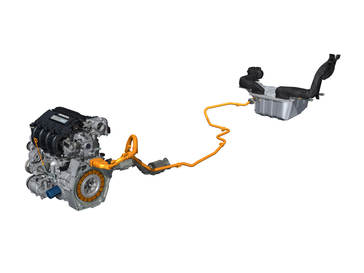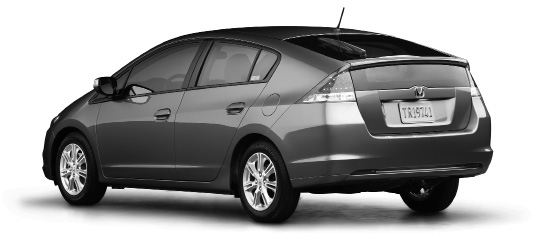
2010 Honda Insight - Overview

A sleek exterior blends design elements from the original Insight’s highly aerodynamic side profile with front-end design reminiscent of the hydrogen-powered FCX Clarity, a marquee environmental vehicle. The 5-passenger Insight offers a spacious-feeling occupant environment with some measurements comparable to larger vehicles. An adaptable cargo area and 60/40 split fold-down seats provide extended utility. A 1.3-liter 4-cylinder i-VTEC gasoline engine and a 10-kilowatt electric motor form the foundation of the Integrated Motor Assist™ (IMA™) hybrid system. The electric motor, positioned inline between the engine and the continuously variable transmission, adds power during acceleration and in certain cruising situations, and recaptures energy from the vehicle’s forward momentum during braking.
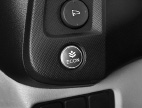
The Insight introduces an all-new Ecological Drive Assist System (Eco Assist™) to help drivers achieve excellent real-world fuel economy. Eco Assist is a driver-selected fuel efficiency feature. Pressing the ECON button can enhance the efficiency of multiple vehicle systems: throttle control, CVT operation, idle stop duration, air conditioning and cruise control operation (EX only). Eco Assist also provides driving style recommendations via a 3D background within the speedometer that changes color to reflect how efficiently the driver is accelerating and braking. Drivers’ results are continuously tracked as fuel economy ratings are shown per drive cycle and on a lifetime basis in the form of plant leaf graphics that can appear in the Multi-Information Display. Up to five leaves can be ‘earned’ as the driver demonstrates a fuel-efficient driving style.
The design of the new Insight features a sleek, futuristic look that speaks to the car’s fun-to-drive characteristics. The flat underbody and related strakes near the wheels help the Insight slip through the air with low levels of turbulence and minimal vehicle drag. The MacPherson strut front suspension and torsion beam rear suspension are tuned to provide sporty performance and a comfortable ride, while the compact component size allows for ample interior space. Low-rolling-resistance tires further enhance the vehicle’s efficiency. The body construction features significant use of high-strength steel, which helps reduce weight and enhance rigidity.
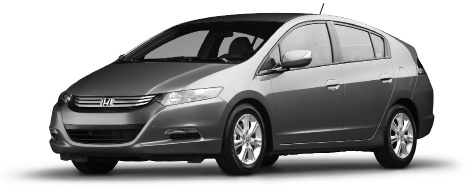
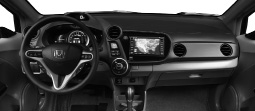
Two trim levels are available—the Insight LX and EX. Top features standard to the Insight LX include an automatic continuously variable transmission, automatic climate control, power windows, power door locks with remote entry, tilt and telescopic steering column and driver’s seat height adjustment, four-speaker 160-watt audio system with CD player, projector-beam headlights and LED brake lights. Features added with the Insight EX include Vehicle Stability Assist™ (VSA®), an electronic stability system; alloy wheels; steering wheel-mounted paddle shifters; a six-speaker audio system; USB audio interface; and turn signal-integrated side mirrors. Also available with the Insight EX are the Honda Satellite-Linked Navigation System™ with Voice Recognition and a Bluetooth® HandsFreeLink™ system.
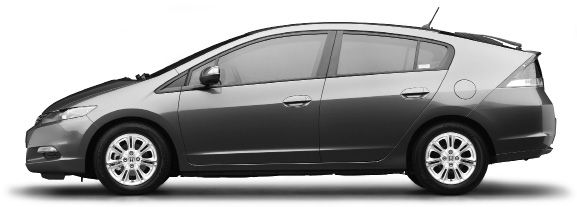
2010 Honda Insight - Concept and Background
A proud tradition of low-emissions, high-mileage innovation
Since the 1970s, Honda has been a pioneer in the development of low-emissions, high-fuel-efficiency automobiles. Today, Honda continues to realize its vision of efficient, environmentally responsible transportation, delivering superior value at a reasonable price.
The 1975 Honda CVCC Civic featured Compound Vortex Controlled Combustion to become the first vehicle to comply with the US Clean Air Act without a catalytic converter. The 1985 Honda 1.3-liter CRX HF offered superior fuel economy and was followed by the 1992 Honda Civic VX, which featured the lean-burning VTEC-E engine. In combination with a highly efficient continuously variable transmission (CVT), the VTEC-E engine made the 1996 Honda Civic HX Coupe the first automobile equipped with an automatic transmission to make the EPA’s top ten efficient vehicles list.
Then, in 1999 Honda introduced the original Insight, the first gasoline-electric hybrid automobile sold in the U.S., which achieved an astounding EPA-estimated fuel economy of 61 mpg city / 70 mpg highway*. Honda’s original Integrated Motor Assist (IMA) powertrain combined a lightweight and efficient gasoline engine with an ultra-thin electric motor that supplied low-end torque and power assist as needed. The Insight also featured a special aluminum body that weighed 40 percent less than a comparable steel body.
Having proved the effectiveness of IMA technology, Honda launched the Civic Hybrid in Japan in 2001 and in the U.S. in 2002 as a 2003 model year vehicle. Along with the exceptional fuel efficiency offered by IMA, the Civic Hybrid featured 5-passenger comfort and the style and amenities of a sedan. Since then, Honda’s hybrid technology has continued to evolve, and Civic and Accord hybrid models have featured increasingly advanced IMA technology and enhanced hybrid performance.
The Honda hybrid evolves
| Vehicle Type | 2000 Insight | 2003 Civic Hybrid | 2005 Accord Hybrid | 2006 Civic Hybrid | 2010 Insight |
| Wheelbase (in.) | 94.5 | 103.1 | 107.9 | 106.3 | 100.4 |
| Engine Type | In-Line 3-Cylinder | In-Line 4-Cylinder | V-6 | In-Line 4-Cylinder | In-Line 4-Cylinder |
| Horsepower @ rpm (SAE net, engine + motor) |
67 @ 5700 | 85 @ 5700 | 255 @ 6000 | 110 @ 6000 | 98 @ 5800 |
| Motor Output (hp @ rpm) | 13 @ 3000 | 13 @ 4000 | 16 @ 840 | 20 @ 2000 | 13 @ 1500 |
| Battery Capacity (Ah) | 6.5 | 6.0 | 6.0 | 5.5 | 5.75 |
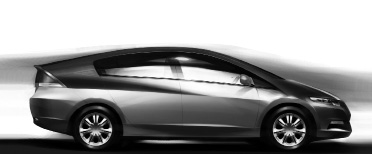
The 2010 Insight: a new era of efficient transportation begins
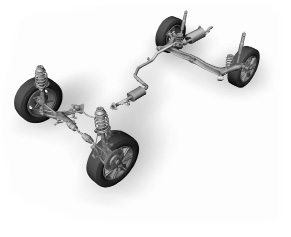
Honda believes that today’s customers are no longer interested in buying a car just because it is a hybrid—they don’t want to compromise. They are looking for a practical vehicle that offers performance, refined styling and of course the fuel economy that a hybrid can deliver.
One day many people may drive fuel cell vehicles, but with concerns over resource conservation and environmental protection growing, customers worldwide are looking for efficient, environmentally responsible transportation now. Offering customers high-quality, affordable hybrid transportation, Honda is striving to expand the positive impact of economical and environmentally responsible vehicles. The 2010 Insight is the first in a new series of Honda hybrid vehicles slated to offer exceptional fuel efficiency, fun driving and practicality in a stylish package at a highly affordable price.
Three advances are the key to the Insight’s attractive combination of features and approachable purchase price. First, the new Insight is a global car, sharing platform and parts with only minor, regional variations. Honda has designed the Insight to comply with standards worldwide—with collision safety tests and emissions standards a high priority. The Insight achieves standards of quality and safety that make it world-ready, and it is designed for efficient high-volume manufacturing.
Second, the new Insight features an Integrated Motor Assist powertrain that is more advanced and compact than ever. As compared to the IMA technology deployed in the 2006 Civic Hybrid, the IPU is 19 percent more compact and 28 percent lighter.
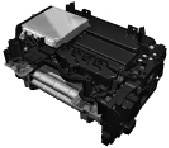
Third, to produce the Insight, Honda has created assembly lines at its Suzuka Factory in Japan for the manufacture of IMA components that feature the company’s most advanced equipment and manufacturing technology, providing for both the highest quality and reduced cost to maximize value.
The result is an automobile that builds upon the Honda tradition of innovation to offer not only low emissions and high fuel economy, but also exceptional performance, style and utility, all at the most affordable price.
*Note: EPA fuel economy rating adjustments occurred for the 2008 model year in an effort to make government ratings better reflect “real world” effects. Though the same test procedures are used, in 2008, city results were reduced by 12% on average and highway results by 8% on average. The non-adjusted pre-2008 EPA figures are shown for pre-2008 models. Consequently, fuel economy ratings before and after 2008 cannot be directly compared unless adjusted first.
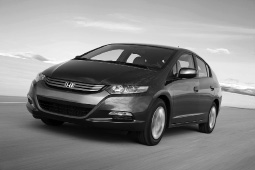
2010 Honda Insight - Safety
Safety Technologies
In addition to being environmentally responsible, the new Insight demonstrates a commitment to safety in its design and construction. The Advanced Compatibility Engineering™ (ACE™) body structure helps protect occupants. Additional safety technologies include standard dual-stage, dual-threshold front airbags, standard front-side and side-curtain airbags, 3-point seat belts with front seat automatic tensioning system, active front seat head restraints, an anti-lock braking system (ABS) with Electronic Brake Distribution (EBD) and a tire pressure monitoring system (TPMS).
- Advanced Compatibility Engineering™ (ACE™) body structure
- Vehicle Stability Assist™ (exclusive to Insight EX)
- Pedestrian injury mitigation design elements in the front of the vehicle
- Standard dual-stage, dual-threshold front airbags and front-side airbags with front passenger Occupant Position Detection System (OPDS)
- Side curtain airbag system (front and rear)
- 3-point front seat belts with automatic tensioning system and load limiters
- 3-point rear seat belts
- Driver- and front-passenger Active Head Restraints
- Adjustable rear seat head restraints
- LATCH (Lower Anchors and Tethers for CHildren)
- Anti-lock braking system (ABS) with Electronic Brake Distribution (EBD)
- Tire pressure monitoring system (TPMS)
Advanced Compatibility Engineering™ (ACE™) body structure
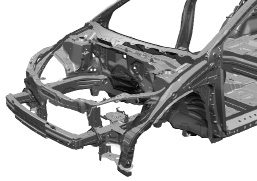
The 2010 Insight features Advanced Compatibility Engineering™ (ACE™) body structure technology which helps enhance the vehicle’s ability to absorb the energy of a frontal crash. The ACE™ body structure also helps minimize the potential for under-ride or over-ride during head-on or offset frontal collisions with a larger or smaller vehicle. It creates a network of fully integrated load-bearing elements in the front of the vehicle that helps attenuate peak impact forces by more evenly distributing them across a relatively large area in the front of the vehicle.
Unlike most conventional designs that direct frontal crash energy only to the lower load-bearing structures in the front end, the ACE™ body structure actively channels frontal crash energy to both upper and lower structural elements, including the floor frame rails, side sills and A-pillars. By engineering specific ‘pathways’ that help distribute these frontal impact forces throughout a greater percentage of the vehicle’s overall structure, the ACE™ body structure can more effectively route them around and away from the passenger compartment to help limit cabin deformation and further improve occupant protection. Integral to the ACE™ body structure concept is its unique front main structure composed of polygonal frame members.
Pedestrian injury mitigation design elements in vehicle front

The Insight is designed to help absorb energy in the event of a frontal collision with a pedestrian. Research by Honda shows that the following features can dramatically reduce the level of pedestrian injury in a collision.
1Impact energy-absorbing hood
Space is provided over engine room components to allow the hood to bend and deform, absorbing impact energy.
2Deformable hood hinges
The hood hinges are designed to deform easily.
3Impact energy-absorbing front fenders
The front fender mounts and brackets are designed to deform easily to help absorb impact energy.
4Deformable windshield wiper pivots
The wiper pivots are designed to deform and break away easily.
Occupant protection
Standard dual-stage, dual-threshold front airbags
Both the driver and front passenger are protected by advanced front airbags that incorporate dual-stage and dual-threshold activation technology. These features work together in the event of a deployment while helping minimize injuries sometimes caused by airbags. Honda’s sophisticated dual-stage, dual-threshold system is designed to optimize the deployment rate to match the severity of a crash event.
Front-side airbags with front passenger Occupant Position Detection System (OPDS)
Side airbags mounted in the outboard area of each front seatback are designed to provide upper torso protection in the event of a severe side impact. In addition, the front passenger seat is equipped with an Occupant Position Detection System (OPDS), an innovative system designed to deactivate the side airbag if a child or small-statured adult leans into the side airbag deployment path.
Side curtain airbag system
The side curtain airbag system is designed to rapidly deploy in the event of a side collision to help protect the heads and necks of occupants. The large airbag covers almost the entire side window area, utilizing a low-temperature, compressed gas inflator to inflate. No fewer than six sensors are used to detect side collisions and determine optimum timing for airbag deployment.
Honda’s safety R&D facilities
Honda operates two of the world’s most sophisticated crash test laboratories for the development of improved safety designs and technologies. The Tochigi, Japan facility is the world’s first indoor multi-directional car-to-car crash testing facility and plays a critical role in the development of enhanced designs for occupant and pedestrian safety and vehicle-to-vehicle compatibility. Honda R&D America’s Raymond, Ohio development center performs advanced testing on all U.S.-developed models. The facility features the world’s first pitching test sled, which aids efficiency by enabling economical and speedy crash-test simulations with certain interior safety components, such as seats and seatbelts, prior to conducting a crash test with an actual vehicle. It also features one of the world’s highest-resolution impact barriers, which enables precise measurement of the distribution of impact load forces on a vehicle, allowing for even more advanced vehicle designs.
2010 Honda Insight - Powertrain
A balanced approach to power, compactness and efficiency
Now in its fifth generation since debuting on the original Insight in 1999, Honda’s Integrated Motor Assist (IMA) is a parallel hybrid powertrain that increases efficiency through power assist, energy regeneration and idle stop capabilities. The system consists of a low-friction 1.3-liter SOHC 8-valve i-VTEC 4-cylinder engine that serves as the primary power source; a 10-kilowatt, lightweight, ultra-thin electric motor that provides additional power and electricity generation; a lightweight and compact battery; and a continuously variable transmission. The combined output and overall torque of the engine and motor (max. output 98 hp @ 5,800 rpm, max. torque 123 lb-ft. @ 1,000–1,500 rpm) allow for responsive acceleration in the city and confidence-inspiring performance on the highway. The IPU of the new IMA is 19 percent more compact than that of the fourth-generation system, contributing to spaciousness and utility, while the powertrain’s efficiency is the key to the Insight’s exceptional fuel economy: Honda estimated EPA combined fuel economy of 41 mpg* and a 10.6-gallon fuel tank deliver a maximum range of over 400 miles.
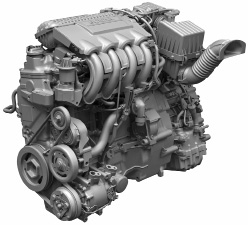
- Fifth-generation Integrated Motor Assist (IMA) hybrid system
- 1.3-liter SOHC 8-valve i-VTEC 4-cylinder engine
- High-power, lightweight, ultra-thin electric motor
- Lightweight, compact, durable battery
- Standard continuously variable transmission (CVT)
- Regenerative braking
- Drive-by-Wire™ throttle control
High-efficiency, lightweight, low-friction 1.3-liter SOHC i-VTEC 4-cylinder engine
The heart of the Insight powertrain is the i-VTEC engine, which combines responsive performance and excellent fuel efficiency as a result of its lightweight, low-friction and efficient design. Rated output is 88 hp @ 5,800 rpm, and rated torque is 88 lb-ft. @ 4,500 rpm. Key features of the engine include the following:
The i-VTEC valve control system employs a dual-rocker configuration that supports both normal valve timing and cylinder idling to achieve a broad power band combined with excellent fuel efficiency.
The lightweight engine block incorporates a thin-sleeve construction, while friction-reducing measures include plateau honing, low-friction pistons, low tensile-force piston rings and an offset cylinder bore. The surfaces of the high-strength forged steel connecting rods have been hardened with a special carbon process for a more lightweight design.
The Programmed Fuel Injection (PGM-FI) is a lightweight, compact system that ensures optimal air-fuel ratio by monitoring throttle position, engine temperature, intake-manifold pressure, intake-air mass flow atmospheric pressure, exhaust-gas oxygen content and intake-air temperature to control fuel delivery via multi-holed injectors mounted in the intake port of the cylinder head. The intake manifold is made of lightweight, composite resin instead of aluminum for further weight savings.
Intelligent dual and sequential ignition with two spark plugs per cylinder facilitates an intense, rapid combustion process for increased power and reduced fuel consumption and emissions.
A subframe torque rod damper system reduces rocking and helps isolate powertrain noise and vibration from the passenger compartment. Hydraulic engine mounts and reinforcements in the engine compartment help further reduce engine noise and vibration for a more comfortable ride.
During deceleration, Variable Cylinder Management (VCM) virtually eliminates the pumping action of the cylinders, decreasing resistance to allow the motor/generator to more efficiently generate electricity with which to charge the battery.
*Based on 2010 EPA mileage estimates, reflecting new EPA fuel economy methods beginning with 2008 models. Use for comparison purposes only. Do not compare to models before 2008. Your actual mileage will vary depending on how you drive and maintain your vehicle.
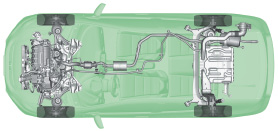
High-power, lightweight, ultra-thin DC brushless electric motor
The motor contributes up to 13 hp (10 kilowatts) @ 1,500 rpm and 58 lb-ft. of torque @ 1000 rpm to the Insight’s powertrain, assisting in acceleration and some steady state cruising situations at low-to-mid vehicle speeds (depending on conditions). The motor also acts as a generator during braking, steady cruising, gentle deceleration and coasting to capture kinetic energy and recharge the battery. The ultra-compact electric motor is located between the engine and transmission.
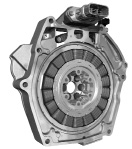
Notable: When driving on a flat surface at steady speed in the low 30 mph range, for example, it is possible for the driver to determine that the vehicle is being propelled exclusively by the electric motor when the IMA System Power Flow Indicator on the Multi-Information Display shows that only the battery is providing power.
Lightweight and compact Intelligent Power Unit (IPU)
The Intelligent Power Unit (IPU) controls the power of the IMA system. The IPU contains the energy storage module (battery), Power Control Unit (PCU), motor Electric Control Unit (ECU), and a compact cooling system. The IPU is located beneath the rear cargo area for minimal impact on interior space.
The nickel metal hydride (Ni-MH) battery system consists of seven modules that serve power to the electric motor as it assists the engine. It also stores the electricity when the motor generates electricity during regenerative braking. The seven-module battery system is comprised of 84 individual “D-sized” 1.2 volt cells for a total battery system output of 100.8 volts and a capacity of 5.75 ampere-hours.
Compared to the fourth-generation IMA battery technology in the 2006 Civic Hybrid, power output per module is 30 percent higher, allowing for a decrease in modules from 11 to 7. The changes allowed the overall IPU size to be reduced by 19 percent and overall weight by 28 percent. This decreased size and weight along with the corresponding reduced use of materials have also resulted in a battery with a lower lifetime environmental burden.
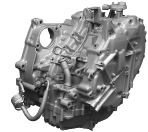 Continuously variable transmission (CVT)
Continuously variable transmission (CVT)
The CVT offers smooth and predictable transitions and excellent low-end acceleration and low-rpm cruising. By helping the engine and IMA motor stay in their most efficient operating range, the CVT provides a fuel efficiency benefit superior to that of a conventional automatic transmission with gears, and it allows for greater efficiency during regenerative braking by smoothing deceleration. The use of a lower gear ratio results in quick-reacting initial acceleration performance. The start clutch control is redesigned to take full advantage of the features of the IMA system, engaging at lower rpms to enhance initial acceleration and contribute to fuel efficiency.
Regenerative braking
The Insight’s regenerative braking system intelligently apportions braking power between the hydraulic brakes and the electric motor to extract even more electricity from the vehicle’s kinetic energy. Less reliance on the traditional braking system and reduced engine pumping losses translate into greater electrical regeneration and improved fuel efficiency. During braking, a braking pressure sensor sends a signal to the IPU, which maximizes the level of regenerative braking.
Automatic idle stop
The Insight automatically turns off the gasoline engine during complete stops under normal operating conditions. This feature allows the vehicle to use even less fuel and emit fewer emissions than a conventional automobile. The system uses the IMA electric motor to restart the engine.
Drive-by-Wire™ throttle control
Continuously optimizing the ratio of movement between the throttle pedal and the throttle butterfly valve in the intake manifold, Drive-by-Wire optimizes engine response and IMA operation to match driving conditions and driver expectations for throttle input response. The system uses a highly responsive DC motor to change the throttle position quickly and precisely.
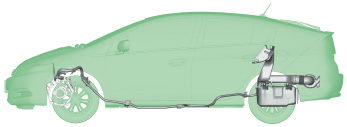
2010 Honda Insight - Environmental Performance
Superior fuel economy, low emissions and driver participation
The new Insight is designed to help drivers achieve superior real-world fuel economy.
Thanks to advanced aerodynamics, a highly efficient powertrain, and new functions like Eco Assist™, the new Insight features superior real-world fuel economy and low emissions. Estimated EPA fuel economy is 40 mpg city / 43 mpg highway / 41 mpg combined. Certified as an Advanced Technology Partial Zero Emission Vehicle (AT-PZEV) by the California Air Resources Board (CARB), the Insight has been designed to comply with top-level emissions guidelines. In addition, the Ecological Drive Assist System (Eco Assist™) is a fuel economy information system designed to help the driver develop and maintain a fuel-efficient driving style. The system monitors driving style, and can display the impact of a driving style on the vehicle’s fuel economy. The system also provides feedback that can help the driver make adjustments to driving style. By pressing the ECON button, the driver may choose to trade off a measure of performance to enhance fuel economy. The efficient new IMA powertrain and the driving guidance provided by Eco Assist™ help the Insight provide a balanced approach between efficient highway commuting and efficient city driving.
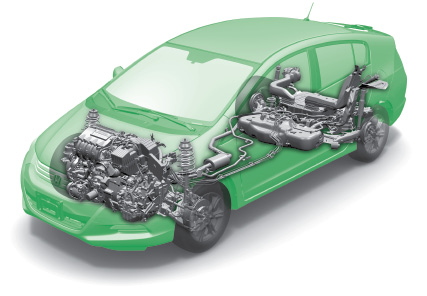
- Estimated city/highway/combined fuel economy of 40/43/41 miles per gallon*
- AT-PZEV certification from CARB (projected)**
- New Eco Assist™
- ECON mode for enhanced fuel economy
- Speedometer background changes color to indicate driving style efficiency
- Feedback on current and long-term driving practices via the Eco Guide
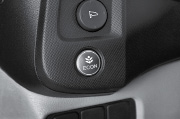
ECON mode for enhanced fuel economy
Pushing the ECON button initiates a range of functions that increase the fuel economy of the new Insight’s Integrated Motor Assist (IMA) system:
- Increases the potential for engaging the idle stop feature sooner
- Operates air conditioning more in recirculation mode
- Reduces automatic climate control blower fan speed
- Optimizes throttle angle input and CVT operation
- Limits power and torque by approximately 4 percent (full responsiveness is provided at wide-open-throttle)
- Cruise control operation (EX only)
Eco Assist™ provides guidance on mileage-boosting driving practices
The new Insight offers exceptional fuel economy, and the new Eco Assist™ guidance function helps drivers get improved efficient performance from the Integrated Motor Assist system. The system guides drivers in accelerating and braking in ways that consume less fuel, and in taking better advantage of regenerative braking. Using these tools, the driver can achieve improved fuel economy performance.
Speedometer background changes color to indicate driving style efficiency
The feedback provided by Eco Assist™ simply and effectively helps drivers accelerate and brake in ways conducive to enhanced fuel economy. Fuel-saving activities like smooth acceleration and braking make the speedometer background glow green. Somewhat less-efficient driving makes the meter glow blue-green. Aggressive starts and stops that consume extra fuel make the meter glow blue. By observing the speedometer background’s response to driving practices and seeking to achieve a consistently green color, drivers can receive assistance in developing driving habits that typically enhance fuel economy.
AT-PZEV emissions
The Insight qualifies as an Advanced Technology Partial Zero Emissions Vehicle (AT-PZEV) with the California Air Resources Board (CARB).
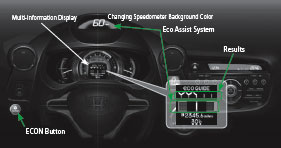
Feedback on current and long-term driving style via the Eco Guide
The Multi-Information Display offers drivers a selection of informational displays, including an Eco Guide, in which the number of ‘leaves’ displayed indicates the level of environmentally responsible driving performance. Also, a bar extends to left or right to indicate fuel-efficient driving. A shorter bar to the right indicates a more efficient acceleration style. Similarly, a shorter bar to the left indicates a more efficient braking style. When the ignition switch is turned off, the ‘leaves’ in the top line of the display score driving in the just completed driving cycle (startup to shutdown), and a horizontal bar in the lower part of the display indicates cumulative performance. The scoring function encourages drivers to take an interest in developing fuel-efficient driving habits over the long term. If drivers prefer not to monitor fuel economy on the MID, they can switch this screen to another of their choice, such as the Integrated Motor Assist (IMA) schematic.
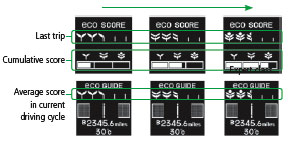
*Based on 2010 EPA mileage estimates, reflecting new EPA fuel economy methods beginning with 2008 models. Use for comparison purposes only. Do not compare to models before 2008. Your actual mileage will vary depending on how you drive and maintain your vehicle.
**AT-PZEV models are certified by the California Air Resources Board (CARB) and are available in California and certain states that adopted the CARB certification standards (CA, CT, MA, ME, NJ, NY, OR, RI, VT).
2010 Honda Insight - Chassis
Occupant comfort and sporty handling
In addition to providing a smooth, comfortable ride, the chassis of the new Insight helps create a roomy interior through the use of MacPherson struts for the front suspension and an H-shaped torsion beam for the rear. The low vehicle height and the placement of the battery and other hybrid components beneath the rear cargo area further contribute to spaciousness and the low center of gravity, which is key to the new Insight’s responsive, sporty handling. Electric power-assisted rack-and-pinion steering enhances driving performance, while the antilock braking system (ABS) with Electronic Brake Distribution (EBD) provides a natural, easy-to-control, linear braking feel. Further refining the advanced suspension implemented on the 2009 Fit, Honda has introduced further refinement to match the characteristics of the new Insight.
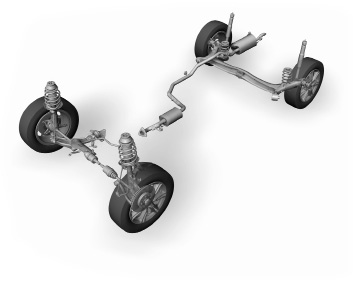
- MacPherson strut front suspension
- H-shaped torsion beam rear suspension
- Low center of gravity for superior handling
- Electric power-assisted rack-and-pinion steering (EPS)
- Power-assisted ventilated front disc brakes, rear drum brakes
- Antilock braking system (ABS) and Electronic Brake Distribution (EBD)
- Low rolling-resistance tires
- 15-inch wheels (alloy wheels on Insight EX)

MacPherson strut front suspension
In the front, MacPherson struts offer outstanding space efficiency. Fine-tuned suspension geometry secures optimum wheel alignment during turning for a solid handling feel. The axes of the suspension arm mounting points have been aligned and compliance-bushing axes made parallel for enhanced ride smoothness and comfort.
H-shaped torsion beam rear suspension
In the rear, an H-shaped torsion beam suspension helps free up more cabin space. A low spring lever ratio and large-capacity trailing arm bushings contribute to the Insight’s smooth ride. Long trailing arms help suppress jack-up during cornering, while optimized roll steer and roll camber geometry deliver superb handling.

Low center of gravity for enhanced handling
The low vehicle height of 56.2 in., the location of the battery and other hybrid components beneath the rear cargo area and other design factors result in a low center of gravity, contributing to the new Insight’s responsive, lively handling capabilities.
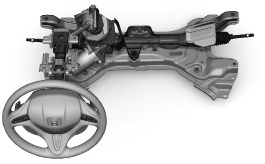
Electric power-assisted rack-and-pinion steering (EPS)
In combination with finely tuned suspension geometry, a high steering gear ratio in the initial 90-degree rotation of the steering wheel and advanced EPS control deliver a crisp steering response to driver inputs at all speeds. The mounting method and rigidity of the new Insight’s steering box complement the EPS system’s high capacity and quick steering gear ratio, adding to the firm, direct steering feel. Unlike traditional hydraulically powered systems, the EPS does not draw power from the engine, further contributing to the new Insight’s overall fuel efficiency.
Power-assisted ventilated front disc brakes and rear drum brakes with antilock braking system (ABS) and Electronic Brake Distribution (EBD)
The 10.3 in. ventilated front discs and 7.9 in. rear drum brakes are supported by a standard 4-channel antilock braking system (ABS) and Electronic Brake Distribution (EBD). EBD optimizes front-to-rear brake pressure according to vehicle load distribution, enhancing stopping performance. Sensors at each wheel send signals to the control module, optimizing the brake pressure balance of all four wheels based on individual wheel speed. A small-diameter, long piston-stroke brake master cylinder adds to the firm, natural, easy-to-control and linear braking feel.

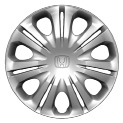
15-inch wheels with full covers
The 15-inch spoked wheels have a dynamic, sculpted look that reflects the Insight’s sporty performance. The spoke surface widens as it approaches the outer rim, catching light to make the wheels look larger and underline the Insight’s broad stance.
2010 Honda Insight - Body
Structure and Styling
Rigid, lightweight, quiet and stylish
The body of the new Insight features Advanced Compatibility Engineering™ (ACE™) body structure in the vehicle front to help protect occupants in the event of a frontal collision. ACE also enhances rigidity, contributing to the Insight’s responsive, sporty handling. The body of the Insight makes extensive use of high-tensile steel and other light materials, helping to keep vehicle weight and fuel consumption low. The new Insight features a number of design innovations to minimize noise, vibration and harshness for a quieter, more comfortable ride.
An advanced aerodynamic design not only enhances fuel efficiency, it also gives the new Insight its sleek, futuristic style—clearly identifiable as a hybrid. The distinctive 6-point front grille highlights the front bumper face that flows up and to the sides, emphasizing the vehicle’s stable, wide stance. The taut, lean body lines that sweep back along the sharp wedge profile and taper to the aerodynamic tail are designed for superior aerodynamics and fuel efficiency and to give the Insight its athletic, stylish look.
- Advanced Compatibility Engineering™ (ACE™) body structure in the front of the vehicle
- Pedestrian injury mitigation design in the front of the vehicle
- Rigid, lightweight body design
- Body designed for optimum vibration frequency control
- Advanced aerodynamic design with low vehicle height
- Slim-profile projector-beam halogen headlights
- LED brake lights
- Roof-mounted antenna
- Rear window wiper/washer
- Security system with engine immobilizer
- Seven available exterior colors
Advanced aerodynamic design with low vehicle height
Excellent aerodynamic design, including a low vehicle height and extremely flat underbody, not only aids in performance and fuel efficiency, but also gives the new Insight a characteristic profile that makes it immediately identifiable. Distinctive design elements include Honda’s unique six-point grille, a sharp wedge profile, and an aerodynamic tail. Details like the roof-mounted antenna and rear window wiper/washer are practical while adding to overall value, and a selection of seven exciting color schemes complements the external design.
Lightweight sound-absorption materials
Lightweight sound-absorption in the roof, carpets and dashboard help keep the cabin quiet and vehicle weight down. Plastic separators under the pillars enhance cabin quietness.
Advanced windshield design
The laminated windshield glass provides heat and sound insulation to help maintain cabin quietness while reducing the need for heating and air conditioning, conserving energy.
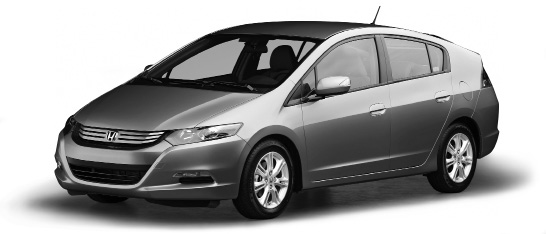
Body designed for optimum vibration frequency control
Each type of automobile vibration, including idling noise and cruising hum, has its own resonance frequency. To disperse these frequencies and ensure a smooth, quiet ride, the body of the new Insight is more rigid where stresses accumulate, such as the attachment points connecting the front pillar lower base stiffener, the center pillar lower base stiffener and the side sill member.
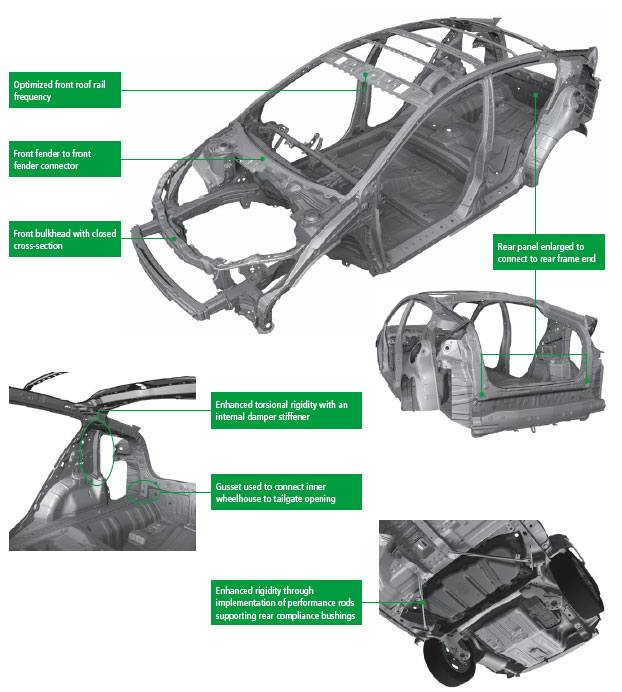
Aerodynamic underbody design
The underbody is designed for optimal aerodynamics to enhance fuel economy. Lightweight plastic parts under the floors, the engine chamber, the fuel tank and other areas of the underbody help enhance air flow. The front spoiler and front and rear strakes help direct air flow strategically. An air guide under the front bumper directs the flow of air into the engine chamber. The result is a Cd reduced some 7%.
Slim-profile projector-beam halogen headlights
The new Insight’s four-light headlight system features hexagonal main reflector units and a horizontal crease to further enhance the slim, advanced visual effect. The low beam units feature blue-colored detailing to reinforce the clean look, while the amber turn signals in the lower bumper face integrate the whole and emphasize the vehicle’s low-to-the-ground stance.
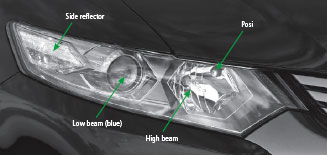
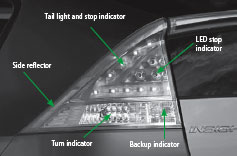
Sculpted LED brake lights
The LED brake light system features attention-grabbing point lighting for the brake lights and soft-glowing surface lighting for the tail lights. The sculpted, three-dimensional look of the units makes the rear of the Insight even more striking in appearance. And the LED lighting contributes to the vehicle’s overall efficiency.

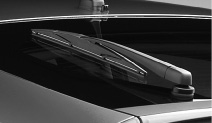
Seven attractive color schemes
The new Insight comes in seven color schemes that accentuate its sporty appearance. Clear Sky Blue is an all-new color exclusive to the new Insight.
- Clear Sky Blue Metallic (new and exclusive to Insight)
- Spectrum White Silver Pearl
- Alabaster Silver Metallic
- Polished Metal Metallic
- Crystal Black Pearl
- Atomic Blue Metallic
- Tango Red Pearl
2010 Honda Insight - Interior
Modern hybrid style and comfort
The interior of the new Insight offers an exploration the hybrid driving experience while providing a superior level of comfort to all occupants. With its visually intuitive two-tier instrument panel and Multi-Information Display, the convex cockpit provides a secure, enclosed feeling, making it easy for drivers to focus on road and vehicle conditions simultaneously. At the same time, front and rear passengers experience a modern, expansive and comfortable cabin offering exceptional utility. The interior finish is futuristic and stylish, while amenities include power windows, mirrors and door locks; standard automatic climate control; a tilt and telescopic steering column and seat height adjustment; a 160-watt AM/FM/CD audio system with MP3 auxiliary jack; and a Maintenance Minder System™ that keeps drivers informed of important maintenance needs as they arise in real time.
- Futuristic cockpit with two-tier instrument panel and Multi-Information Display
- IMA system performance indicators
- Power windows, mirrors and door locks
- Automatic climate control
- Tilt and telescopic steering column and seat height adjustment
- Modern and stylish interior finish
- 160-watt AM/FM/CD audio system with MP3/auxiliary input jack, 4 speakers, speed-sensitive volume control, and radio data system (radio data system not available with navigation)
- Maintenance Minder System™
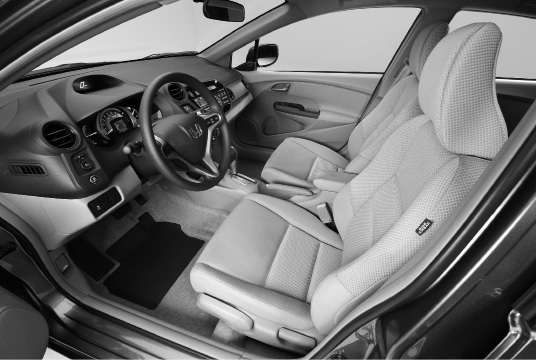
Modern and stylish interior finish
The new Insight’s interior features light warm gray as a base color and dark royal blue on the upper dashboard. Reddish overtones in both colors are designed to create a sense of unity. The seats are pale warm gray or deep blue, while the interior trimmings are pale warm gray. Leather-grain surface treatment with alternating geometric patterns contrast with the dotted pattern mesh jersey seats with wave pattern suede-like tricot bolsters.

Advanced cockpit with two-tier instrument panel and Multi-Information Display
The instrument panel features a sculpted design to create the appearance of depth and expansiveness. In the Multi-Information Display, large 3D meters and tightly clustered controls ensure quick recognition and intuitive operation for a combination of functionality and visual appeal.
Hybrid system performance indicators
To help the driver get optimal performance from the Integrated Motor Assist (IMA) hybrid system, the cockpit of the new Insight features a range of specialized indicators (see Environmental Performance for details).
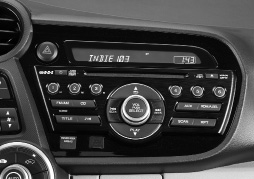
Audio system
The new Insight features a 4-speaker, 160-watt AM/FM/CD audio system (6 speakers in the Insight EX) with an auxiliary input jack for an MP3 player and Windows Media® audio playback capability. The new Insight EX is also equipped with a USB audio interface* for connecting an iPod** or other compatible audio device. Other audio features include speed-sensitive volume control, which automatically adjusts the volume based on vehicle speed, and CD/MP3 text readout with a customizable welcome screen. The radio data system shows supplemental programming information from participating radio stations while also offering search-by-genre capability (not available on the Insight EX with navigation).
Maintenance Minder System™
The Maintenance Minder System™ automatically indicates when to have standard service performed based on actual driving conditions. The display indicates when to change the oil, air filter, transmission fluid, spark plugs and coolant, as well as when to rotate the tires.
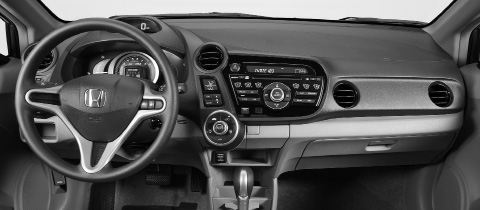
Insight LX instrument panel
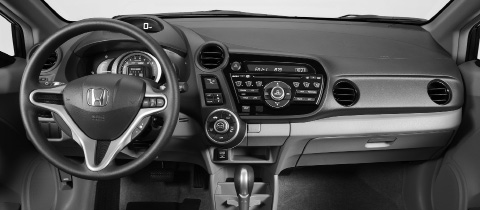
Insight EX instrument panel
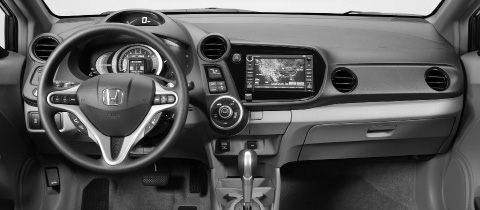
Insight EX Navi instrument panel
* The USB audio interface is used for direct connection to and control of some current digital audio players and other USB devices that contain MP3, WMA® or AAC music files. Some USB devices with security software and digital rights-protected files may not work. Please see your dealer for details on compatibility.
** iPod is a registered trademark of Apple Inc., registered in the U.S. and other countries. iPod not included. Compatible devices include 5th-generation iPods and later and iPod Nano.
2010 Honda Insight - Packaging and Utility
Spacious and comfortable
Classified as a compact with a passenger volume of 85.0 cu-ft. and a cargo volume of 15.9 cu-ft., the new Insight offers a comfortable interior, including generous headroom and legroom for occupants and abundant cargo space along with the superior utility of a 5-door vehicle. The placement of the Intelligent Power Unit (IPU) beneath the rear cargo area frees up extra interior space, allows for more seating configuration flexibility and contributes to low vehicle height and a low center of gravity. This component placement also provides a low seating posture with plenty of headroom and visibility. The wheelbase and overall length allow for a more spacious interior. The Insight’s packaging features a convenient 5-door design with a large lift gate for easy access to cargo and below-floor storage, while 60/40 split rear seats fold down to create a large, flat cargo space, making multiple interior configurations possible. In addition, the new Insight sports a wide variety of storage compartments, pockets and six beverage holders to maximize utility and convenience.
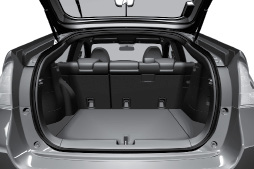
- Spacious interior with headroom and legroom comparable to some larger cars
- Generous cargo space
- Intelligent Power Unit (IPU) located under rear cargo area for extra spaciousness
- Low vehicle height
- Excellent outward visibility
- 5-door utility and functionality
- 60/40 split fold-down rear seats for extra cargo space
- Accommodating storage compartments, pockets and beverage holders
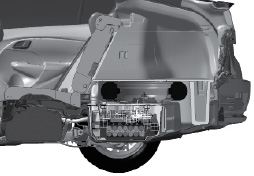
Key hybrid system components located under rear cargo area for extra spaciousness
The Insight’s battery and other Intelligent Power Unit components are more compact than those of the previous IMA, allowing them to be placed beneath the rear cargo area. This design element allows for both a roomier interior and the use of 60/40 split fold-down rear seats for enhanced utility.
Folding down the 60/40 split rear seats connects the rear passenger area to the rear cargo area, creating a large flat surface that accommodates a wide variety of cargo.
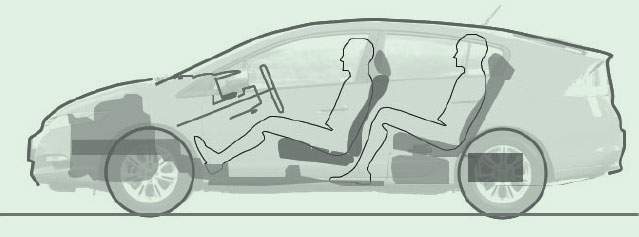
Accommodating storage compartments, pockets and beverage holders
Located throughout the Insight are a wide variety of storage compartments, pockets and beverage holders for extra utility and convenience. With its detachable partition box, the front console can hold two large beverages and smaller items or, alternatively, a tissue box or similar larger object. The carved door linings create space for such everyday objects as maps in the front doors and beverage bottles in the front and rear. In addition, cargo nooks beneath the floor of the cargo area next to the spare tire accommodate jumper cables and other emergency supplies (sold separately), as well as an available accessory cover for the rear cargo area.

Interior configurations
The new Insight can be used in three main interior configurations to accommodate a wide variety of passenger and cargo needs. Fold the rear seats down to create a wide, low, flat cargo area up to 76.2 in. long. With a total capacity of 31.5 cu-ft., this configuration is ideal for moving bulky items or lots of cargo at once. And with all seats in the upright position, 5 people can enjoy the ride.
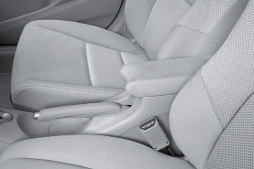
Center console (EX)
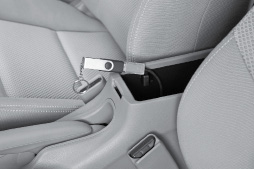
USB audio interface (EX)
2010 Honda Insight Pricing and EPA Data
| Model | Transmission | MSRP* | EPA** City/Hwy/Combined |
| Insight LX | CVT | $19,800 | 40/43/41 |
| Insight EX | CVT | $21,300 | 40/43/41 |
| Insight EX with Navigation | CVT | $23,100 | 40/43/41 |
| *MSRP excluding tax, license, registration, $710.00 destination charge and options. Dealer prices may vary **Based on 2010 EPA mileage estimates, reflecting new EPA fuel economy methods beginning with 2008 models. Use for comparison purposes only. Do not compare to models before 2008. Your actual mileage will vary depending on how you drive and maintain your vehicle. |
|||
2010 Honda Insight Specifications and Features
| ENGINEERING | LX | EX |
| Engine Type | In-Line 4-Cylinder | In-Line 4-Cylinder |
| Engine Block/Cylinder Head | Aluminum-Alloy | Aluminum-Alloy |
| Displacement (L/cc) | 1.3/1339 | 1.3/1339 |
| Horsepower @ rpm (SAE net, combined gasoline engine + IMA motor) | 98 @ 5800 | 98 @ 5800 |
| Torque (lb-ft @ rpm) | 123 @ 1000 - 1500 | 123 @ 1000 - 1500 |
| Redline (rpm) | 6200 | 6200 |
| Bore and Stroke (mm) | 73 x 80 | 73 x 80 |
| Compression Ratio | 10.8 : 1 | 10.8 : 1 |
| Valve Train | 8-Valve SOHC i-VTEC® | 8-Valve SOHC i-VTEC® |
| Multi-Point Fuel Injection | • | • |
| Drive-by-Wire™ Throttle System | • | • |
| Front-Wheel Drive | • | • |
| Ecological Drive Assist System (Eco Assist ™) | • | • |
| Emissions Rating | AT-PZEV / ULEV | AT-PZEV / ULEV |
| Direct Ignition System with Immobilizer | • | • |
| 100K +/- Miles No Scheduled Tune-Ups* | • | • |
| * Does not apply to fluid and filter changes. May vary with driving conditions. See your owner's manual for more details. ** AT-PZEV models are certified by the California Air Resources Board (CARB) and are available in California and certain states that adopted the CARB certification standards (CA, CT, MA, ME, NJ, NY, OR, RI, VT). ULEV-rated in all other states. | ||
| ELECTRIC MOTOR/GENERATOR | LX | EX |
| DC Brusless Motor* | • | • |
| Power Output @ rpm, kW (hp) | 10 (13) @ 1500 | 10 (13) @ 1500 |
| Torque @rpm (lb-ft.) | 123 @ 1000 - 1700 | 123 @ 1000 - 1700 |
| *Note: Permanent Magnet AC Synchronous | ||
| ELECTRIC POWER STORAGE | LX | EX |
| Nickel Metal Hydride (Ni-MH) Battery | • | • |
| Output (Volts) | 100.8 | 100.8 |
| Rated Capacity (ampere-hours) | 5.75 | 5.75 |
| TRANSMISSION | LX | EX |
| Continuously Variable Transmission (CVT) | • | with Paddle Shifter System |
| Gear Ratios: 3.172~0.529, Reverse: 4.511~1.693, Final Drive: 4.20 | ||
| BODY/SUSPENSION/CHASSIS | LX | EX |
| Unit-Body Construction | • | • |
| MacPherson Strut Front Suspension | • | • |
| Torsion-Beam Rear Suspension | • | • |
| Stabilizer Bar (mm, front) | 18.0 / 16.0 | 18.0 / 16.0 |
| Electric Power-Assisted Rack-and-Pinion Steering (EPS) |
• | • |
| Steering Wheel Turns, Lock-to-Lock | 3.29 | 3.29 |
| Steering Ratio | 16.73 | 16.73 |
| Turning Diameter, Curb-to-Curb (ft) | 36.1 | 36.1 |
| Power-Assisted Ventilated Front Disc/Rear Drum Brakes (in, front/rear) |
10.3 / 7.9 | 10.3 / 7.9 |
| Wheels | 15" with Full Covers | 15" Alloy |
| All-Season Tires | 175 / 65 R15 84S | 175 / 65 R15 84S |
| Compact Spare Tire | • | • |
| EXTERIOR MEASUREMENTS | LX | EX |
| Wheelbase (in) | 100.4 | 100.4 |
| Length (in) | 172.3 | 172.3 |
| Height (in) | 56.2 | 56.2 |
| Width (in) | 66.7 | 66.7 |
| Track (in, front/rear) | 58.7 / 58.1 | 58.7 / 58.1 |
| Curb Weight (lbs) | 2723 | 2727 / 2734 (Navi) |
| Weight Distribution (%, front/rear) | 58/42 | 58/42 |
| INTERIOR MEASUREMENTS | LX | EX |
| Headroom (in, front/rear) | 38.4 / 35.9 | 38.4 / 35.9 |
| Legroom (in, front/rear) | 42.3 / 33.5 | 42.3 / 33.5 |
| Shoulder Room (in, front/rear) | 52.7 / 50.4 | 52.7 / 50.4 |
| Hiproom (in, front/rear) | 51.6 / 48.7 | 51.6 / 48.7 |
| Cargo Volume (cu ft, seat up/down) | 15.9 / 31.5 | 15.9 / 31.5 |
| Passenger Volume (cu ft) | 85.0 | 85.0 |
| Seating Capacity | 5 | 5 |
| EPA MILEAGE ESTIMATES*/CAPACITIES | LX | EX |
| CVT (City/Highway/Combined) | 40/43/41 | 40/43/41 |
| Crankcase (qt) | 4.0 | 4.0 |
| Coolant System (qt) | 5.3 | 5.3 |
| Fuel (gal) | 10.6 | 10.6 |
| Required Fuel | Regular Unleaded | Regular Unleaded |
| *Based on 2010 EPA mileage estimates, reflecting new EPA fuel economy methods beginning with 2008 models. Use for comparison purposes only. Do not compare to models before 2008. Your actual mileage will vary depending on how you drive and maintain your vehicle. | ||
| SAFETY | LX | EX |
| 3-Point Seat Belts at all Seating Positions | • | • |
| Adjustable Front Seat Belt Anchors | • | • |
| Driver's and Front Passenger's Seat Belt Reminder | • | • |
| Dual-Stage, Dual-Threshold Front Airbags (SRS) | • | • |
| Front Side Airbags with Passenger-Side Occupant Position Detection System (OPDS) |
• | • |
| Side Curtain Airbags | • | • |
| Driver's and Front Passenger's Active Head Restraints |
• | • |
| Advanced Compatibility Engineering™ (ACE™) Body Structure |
• | • |
| Anti-Lock Braking System (ABS) | • | • |
| Electronic Brake Distribution (EBD) | • | • |
| Vehicle Stability Assist™ (VSA®) with Traction Control |
• | |
| Tire Pressure Monitoring System (TPMS) | • | • |
| Daytime Running Lights (DRL) | • | • |
| Side-Impact Door Beams | • | • |
| Outboard Lower Anchors and Tethers for Children (LATCH) |
• | • |
| Child-Proof Rear Door Locks | • | • |
| Immobilizer Theft-Deterrent System | • | • |
| EXTERIOR FEATURES | LX | EX |
| Roof-Mounted Antenna | • | • |
| Security System with Remote Entry | • | • |
| Body-Colored Folding Power Side Mirrors | • | Heated with Integrated Turn Indicators |
| 2-Speed/Intermittent Windshield Wipers | • | Variable |
| Rear Window Wiper/Washer | • | • |
| Impact-Absorbing Body-Colored Bumpers | • | • |
| Projector-Beam Halogen Headlights with Blue-Tinted Chrome Bezels | • |
• |
| Tinted Glass | • | • |
| Body-Colored Door Handles | • | • |
| LED Brakelights | • |
• |
| COMFORT & CONVENIENCE | LX | EX |
| Air Conditioning with Air-Filtration System | • | • |
| Honda Satellite-Linked Navigation System™ with Voice Recognition |
Available | |
| Bluetooth® HandsFreeLink® | with Navigation | |
| Power Windows with Auto-Up/Down Driver's Window |
• | • |
| Illuminated Window Switches | Driver's window only | • |
| Power Door Locks | • | • |
| Cruise Control | • | |
| Steering Wheel-Mounted Paddle Shifters | • | |
| Tilt and Telescopic Steering Column | • | • |
| Illuminated Steering Wheel-Mounted Controls | • |
• |
| Illuminated Steering Wheel-Mounted Cruise Controls | • | |
| Illuminated Steering Wheel-Mounted Audio, Navigation and Phone Controls | with Navigation | |
| Beverage Holders | 8 | 6 |
| Center Console with Armrest and Storage Compartment | • | |
| Door-Pocket Storage Bins, Front | • | • |
| Driver- and Passenger-Side Seatback Pockets | • | |
| Driver's and Front Passenger's Vanity Mirrors | • | |
| Map Lights | • |
• |
| 12-Volt Power Outlet | • | • |
| Cargo Area Light | • | • |
| SEATING | LX | EX |
| Reclining Front Seatbacks | • | • |
| Adjustable Head Restraints | • | • |
| 60/40 Split Fold-Down Rear Seatback | • | • |
| AUDIO SYSTEMS | LX | EX |
| 160-Watt AM/FM/CD Audio System | with 4 Speakers | with 6 Speakers |
| Radio Data System (RDS) | • | without Navigation |
| MP3/Windows Media® Audio (WMA) Playback Capability |
• | • |
| MP3/Auxiliary Input Jack | • | • |
| USB Audio Interface | • | |
| CD Text Display Capability | • | • |
| Speed-Sensitive Volume Control (SVC) | • | • |
| INSTRUMENTATION | LX | EX |
| ABS Indicator | • | • |
| Airbag System Indicator | • | • |
| Blue Backlit Gauges | • | • |
| Brake System Indicator | • |
• |
| Charging System Indicator | • | • |
| Coolant Temperature Indicators | • | • |
| Cruise Control Indicators | • | |
| Door/Trunk-Open Indicator | • | • |
| DRL Indicator | • | • |
| ECON Button | • | • |
| EPS Indicator | • | • |
| Fuel Level Indicator | • | • |
| Headlight-On Indicator | • | • |
| High-Beam Indicator | • | • |
| Idle-Stop Indicator | • | • |
| IMA Charge and Assist Indicator | • |
• |
| IMA System Indicator | • | • |
| Immobilizer System Indicator | • | • |
| Low Tire-Pressure Indicator | • | • |
| Low-Fuel Indicator | • | • |
| Low-Oil Pressure Indicator | • | • |
| Maintenance Minder Indicator | • | • |
| Passenger-Side Side Airbag-Off Indicator | • | • |
| Seat Belt Reminder Indicator | • | • |
| Security System Indicator | • | • |
| Tachometer | • | • |
| TPMS Indicator | • | • |
| Two-Tier Instrument Panel | • | • |
| VSA System and Off Indicators | • | |
| Multi-Information Display (MID) | LX | EX |
| Average Fuel Economy Indicators (2) | • | • |
| Average Speed Indicator | • | • |
| Bluetooth® HandsFreeLink® | with Navigation | |
| Digital Fuel-Mileage Indicators | • | • |
| Digital Odometer and Digital Trip Meters (2) | • |
• |
| ECO Guide | • | • |
| Elapsed Time Indicator | • | • |
| Exterior Temperature Indicator | • | • |
| IMA Charge and Assist Indicator | • | • |
| IMA System Power Flow Indicator | • | • |
| Maintenance Minder™ System | • | • |
| Miles-to-Empty Indicator | • | • |































































































































































































